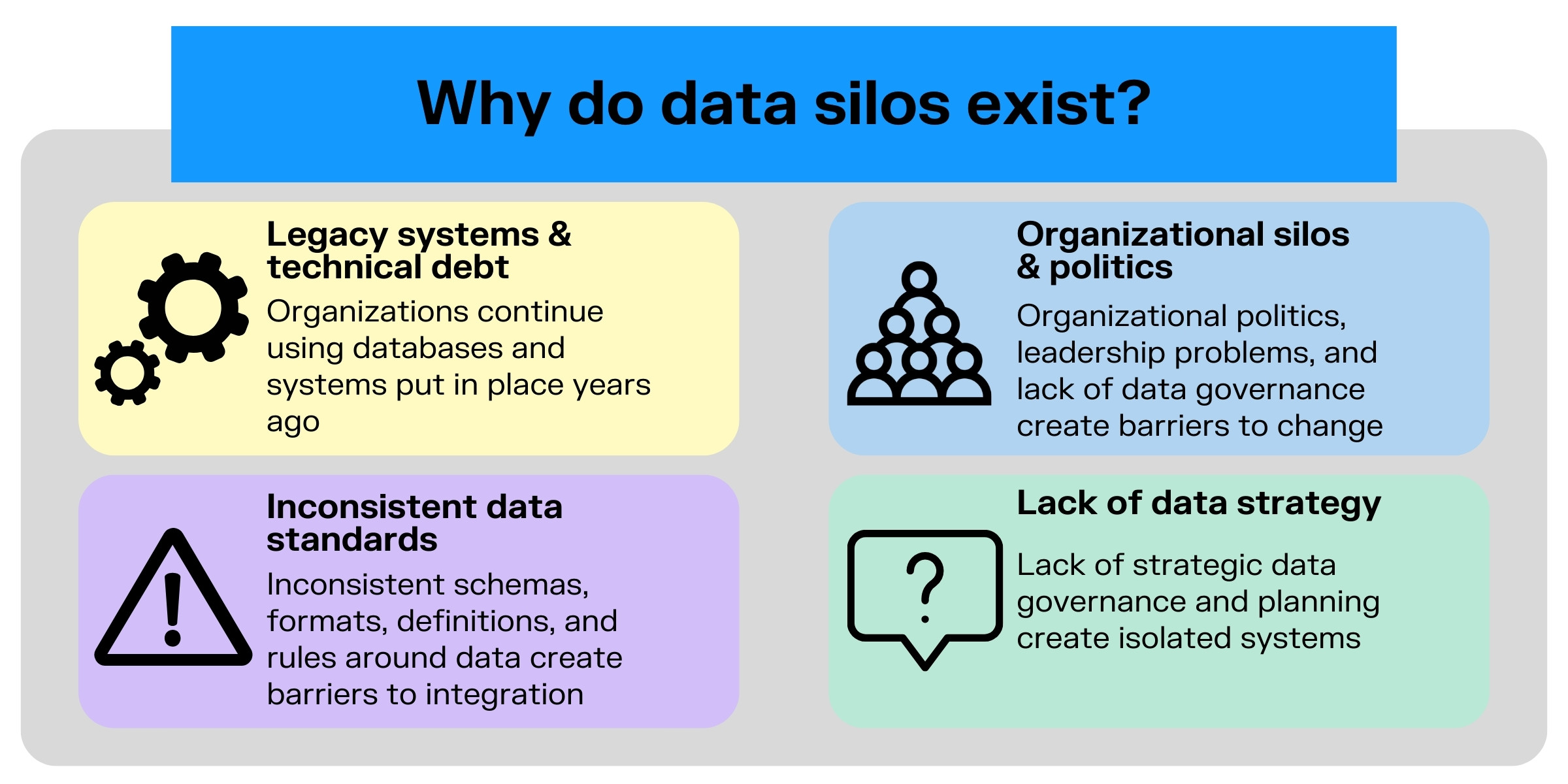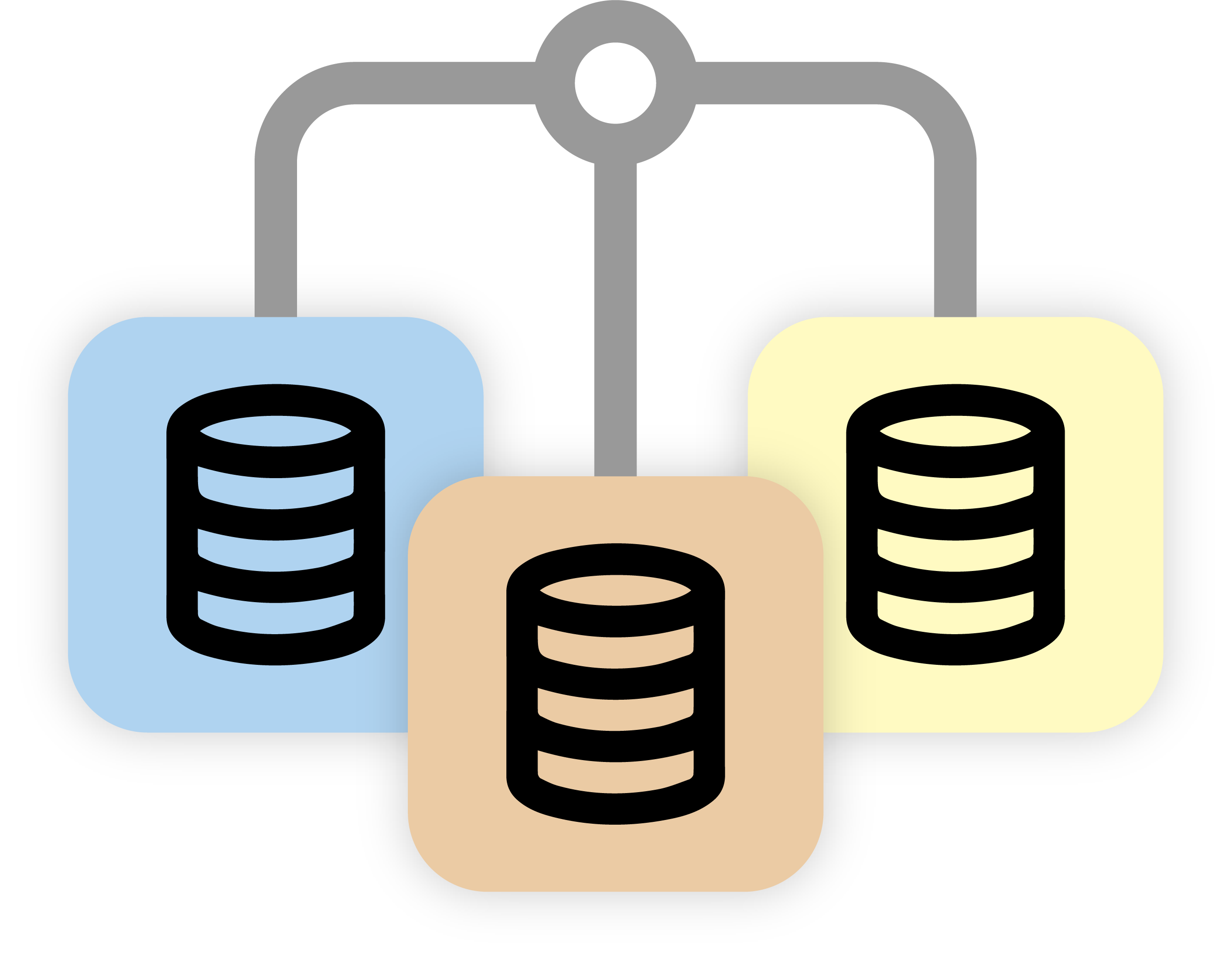If you've ever worked on a team that couldn’t access the same data as another department, you’ve already met a data silo. These invisible barriers appear quietly and grow quickly, leaving organizations with fragmented insights, duplicated work, and decisions shaped more by habit than by facts or reliable decision intelligence.
While “data silos” might sound like just another buzzword, they’re often the reason why even robust companies miss out on real opportunities.
A data silo is exactly what it sounds like: data that’s stored somewhere isolated, inaccessible to others who might need it. It might live in a marketing platform, a finance spreadsheet, or a sales CRM that doesn’t link to anything else.
In theory the data exists, but in practice, it’s invisible to half the organization.
Some examples:
- Sales teams logging customer activity in a tool that marketing can’t see
- Product usage data stored separately from customer support records
- Finance dashboards that are off-limits to other teams
The result? Different versions of the truth, and a lot of second guessing.

Data silos are often created unintentionally as organizations evolve. Multiple factors contribute to their formation:
- Independent tool adoption: Departments may select software that suits their specific needs without considering integration with other systems.
- Organizational structure: Teams operating in isolation, with distinct goals and processes, can lead to fragmented data storage.
- Rapid growth and mergers: As companies expand or merge, integrating different systems becomes challenging.
- Silo mentality: A culture where departments are resistant to share information can reinforce data silos, limiting collaboration.
So while the tools were meant to help teams move faster, they often create walls instead of bridges.

Siloed data doesn’t just slow things down, it weakens trust, agility, and performance. And often, it keeps the most important insights just out of reach. Typically, this is what we see:
- Decisions get made with partial information. When insights are incomplete, choices are based on assumptions rather than reality.
- Teams double up on work. Without a shared view, departments may end up running the same analysis twice and losing precious time, or worse, contradicting each other.
- Customer experience suffers. Ever been asked to repeat your complaint for the third time? That’s a data silo at work.
- Data quality drops. Without central oversight, errors go unnoticed and inconsistencies become the norm.
- Key signals are missed. Siloed data makes it harder to detect emerging risks, unusual behavior, or hidden opportunities that could impact the business.
And these are just the visible effects. The deeper issue is how silos slowly disconnect an organization from itself, limiting not only what teams can see but also what they can act on.
Even within structured systems like databases, silos still happen. A legacy database may hold historical data that newer systems can’t interpret. Or a cloud migration might split records between platforms that were never meant to sync.
In technical terms, a siloed database limits interoperability and query scope. In real terms, it means analysts waste time stitching together exports instead of actually analyzing trends.

Addressing data silos isn't just about implementing new tools, it's about adopting a strategy that combines technology, governance, and culture. These four steps can help you move toward a more connected, silo-free data environment.
- Conduct a data audit: Begin by identifying where data resides, who has access, and how it's used. This helps in pinpointing existing silos and understanding their impact.
- Implement data governance policies: Establish clear standards for data management across departments. This includes defining data ownership, access controls, and quality standards to ensure consistency and reliability.
- Promote a collaborative culture: Encourage communication between teams and data sharing. When teams understand the value of shared data, they're more likely to break down barriers and work together effectively.
- Invest in integration tools: Utilize technologies that facilitate seamless data sharing and integration across systems. This ensures that data flows easily between departments, reducing fragmentation.
While cultural and governance changes are crucial, technology plays an essential role in breaking down data silos. Technical solutions to data silos include:
- Data virtualization: Allows users to access and manipulate data without needing to know its physical location or format. It provides a unified view of data from disparate sources, enabling real-time insights without the need for data replication.
- Data fabrics: A data fabric provides a unified architecture for data management, allowing easy data access and integration across the organization. It connects various data sources, making data available wherever it's needed.
- Unified data platforms: These platforms combine data from various sources into a single, accessible system. They standardize data formats and provide tools for analysis, making it easier for teams to collaborate and make informed decisions.
- Graph technology tools (e.g., Linkurious): Tools like Linkurious offer graph visualization and analytics, enabling organizations to reveal connections within their data. This is particularly useful when dealing with complex datasets from multiple sources.
Bringing in these technologies doesn’t just reduce data fragmentation, it sharpens data quality and helps teams make smarter, faster decisions across the organization.
Breaking down data silos goes beyond smoother operations, it drives better results for the business:
- Improved customer experience: Unified data provides a comprehensive view of the customer, enabling personalized interactions.
- Operational efficiency: Integrated data systems reduce redundancy and simplify processes.
- Informed decision-making: Access to complete and accurate data allows for better strategic decisions.
Smooth, connected data isn’t just a tech win, it’s a game changer for the whole business.
Data silos limit more than efficiency, they block visibility, delay responses, and cause organizations to miss patterns hiding in plain sight. When systems are fragmented, even simple questions become hard to answer. And when data is connected, teams can act faster, detect issues earlier, and reduce risk in ways that make a measurable difference.
- Finance, banking and insurance: Unified data systems improve risk assessment, fraud detection, and customer service by providing a global view of client interactions. Fraud teams, for example, often rely on transaction data, customer history, and third-party reports. When this information is stored across separate platforms, suspicious patterns slip through. With connected data, investigators can link accounts, spot unusual behavior across networks, and surface hidden connections between individuals, companies, and payments. This makes complex fraud easier to detect and prove.
- Cybersecurity: Threat detection depends on connecting signals across logs, access records, and known threat indicators, and when that data is siloed, malicious behavior can go unnoticed. By bringing everything together, it becomes easier to reconstruct attack paths and stop breaches before they spread.
- Telecommunications: A customer complaint might relate to a service outage, a billing error, or a device failure. If these systems do not talk to each other, support teams work in the dark. With connected data, an agent can immediately see the customer’s full journey, from the failed payment to the network alert in their area. This reduces resolution time and improves satisfaction.
- Public sector: When departments and agencies share information, governments can better coordinate responses, allocate resources more effectively, and design policies based on real needs. Siloed data slows down everything from citizen services to emergency planning.
- Supply chain management: Gaining a complete view across suppliers, inventory, and logistics allows companies to respond to disruptions quickly. Without connected data, one blind spot, such as a delayed shipment or compliance issue, can affect the entire chain. With visibility, teams can adapt early, avoiding risks and costly surprises.
Solving data silos lets these industries make the most of their data, driving better outcomes and keeping them ahead of the competition.
Breaking down data silos isn’t just about tidying up systems or making life easier for teams. It’s about setting the stage for something bigger: decision intelligence.
Today, businesses rely on data to guide almost every move, from how they serve customers to where they invest resources. But here’s the problem: when data is scattered across disconnected tools and departments, even the smartest systems can only see part of the picture. You end up with dashboards that look nice but miss important details hiding in the gaps.
For decision intelligence to truly deliver, the data behind it needs to be:
- Accessible
- Connected
- Contextual
Without breaking down silos, patterns stay hidden, important links between data points go unnoticed, and businesses risk making choices based on half the truth.
In short, to turn raw data into clear, confident decisions, you first need to bring that data together, breaking silos and connecting the dots across your organization.
Data silos are usually a side effect of fast growth, legacy systems, or just the human tendency to stick with what’s familiar. But that doesn’t mean they’re harmless. Siloed data keeps organizations in the dark, sometimes without realizing it. The first step to fixing it is acknowledging it’s there.
From there, small shifts lead to bigger changes: teams start aligning, systems begin to connect, and suddenly, decisions have a solid basis and drive better results.
And this is exactly where solutions like Linkurious come in. With graph analytics and powerful visualization, Linkurious helps organizations not just break down silos but actively reveal the connections hidden across their data. Instead of staring at rows of numbers or separate dashboards, teams can finally see the bigger picture. They can understand how people, transactions, and events are linked, and use those insights to make faster, smarter decisions.
Because when your data finally works together, your business can too.
